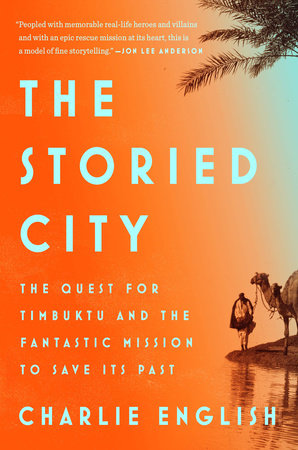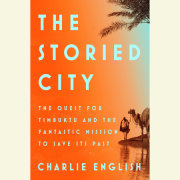1.
A Seeker of Manuscripts
March 2012
One hazy morning in Bamako, the capital of the modern West African state of Mali, an aging Toyota Land Cruiser picked its way to the end of a concrete driveway and pulled out into the busy morning traffic. In its front passenger seat sat a large, distinguished-looking man in billowing robes and a pillbox prayer cap. He was forty-seven years old, stood over six feet tall, and weighed close to two hundred pounds, and although a small, French-style mustache balanced jauntily on his upper lip, there was something commanding about his appearance. In his prominent brown eyes lurked a sharp, almost impish intelligence. He was Abdel Kader Haidara, librarian of Timbuktu, and his name would soon become famous around the world.
Haidara was not an indecisive man, but that morning, as his driver piloted the heavy vehicle through the clouds of buzzing Chinese-made motorbikes and beat-up green minibuses that plied the city’s streets, he was caught in an agony of indecision. The car stereo, tuned to Radio France Internationale, spewed alarming updates on the situation in the north, while the cheap cellphones that were never far from his grasp jangled continually with reports from his contacts in Timbuktu, six hundred miles away. The rebels were advancing across the desert, driving government troops and refugees before them. Bus stations were choked with the displaced; highways were clogged with motorbikes and pickups and ancient trucks that swayed under the weight of the fleeing population. Haidara had known when he left his apartment that driving into this chaos would be dangerous, but now it was beginning to look like a suicide mission. Soon he’d had enough: he spoke to his driver, and then they were pointing west again, back toward the skirts of the sprawling African metropolis.
Responsable is a French noun whose meaning is easy to guess at in English. There were few better words to describe the librarian then than as a responsable for a giant slice of neglected history, the manuscripts of Timbuktu, a collection of handwritten documents so large no one knew quite how many there were, though he himself would put them in the hundreds of thousands. Few had done more to unearth the manuscripts than Haidara. In the months to come, no one would be given more credit for their salvation.
In person the librarian was an imposing man with a handshake of astonishing softness, a drive-by of a greeting that left a hint of remembered contact, no more. He was well versed in the history and content of the documents, but appeared not so much a scholar as a businessman who controlled his affairs in a variety of languages via his cellphones, or in person from behind a desk the size of a small boat. He was not the only proprietor of manuscripts in the city, but as the owner of the largest private collection and founder of Savama, an organization devoted to safeguarding the city’s written heritage, he claimed to represent the bulk of Timbuktu’s manuscript-owning families.
Haidara had been raised in a large Timbuktu house made of banco and built around a courtyard, like a hundred thousand others in the region. He was one of fourteen children of Mamma Haidara, a Timbuktu scholar, and the town in which he grew up had changed little in a hundred years. At the heart of the city were the three large mosques: Jingere Ber, the “great mosque,” in the west; Sidi Yahya in the center; and Sankore in the north. The spaces between the mosques were filled with houses and markets, and the old medina, in the shape of a fat teardrop, was a mile and a half around. The people had buried their relatives close to their houses, and as the city had grown, the burial grounds had been absorbed into the network of alleys and streets. The living and the dead now existed side by side, and in the tradition of mystical, Sufi Islam, the divide between them had become blurred: the most holy ancestors, the scholars and judges and leaders of former times, lay in grand mausoleums where they were worshipped as saints. Someone had counted 333 such saints, and since it was an auspicious number, that was what Timbuktu had come to call itself, the City of 333 Saints.
There were no cars or trucks in Timbuktu when Haidara was growing up; the city did not get its first gas pump until the mid-1970. Instead it was filled with animals. Sheep and goats and cattle and chickens picked at the sparse vegetation and at the scraps thrown in the streets. Caravans of donkeys brought cereals in from the river port to the south, while the biggest events of the year were the arrivals of the salt caravans, thousands of camels strong, from the mines in the desert.
At the age of six, Haidara had been sent to Kuranic school to learn the holy texts, and afterward to the Franco-Arab school to learn everything else. He remembered it as a childhood sans souci, free from worry, but like most Timbuktiens the family had little money. Their principal assets were the manuscripts. These were stored all over the house, Haidara would later recall, on shelves that bowed under the weight of paper, and in relatives’ homes in and around Timbuktu. They were written mostly in Arabic, and were bound in cracking camel and gazelle hide, their fabric eaten by termites and stained with water. They covered almost every subject under the sun. There were works on astronomy, poetry, and medicine, as well as mundane documents of ownership, legal rulings, and bills of sale. More than anything, they were Islamic, commentaries on the holy texts and interpretations of their legal meanings.
Haidara’s father used the manuscripts for teaching. Students came from around the region to learn from the scholar and his books, while his friends—the grandes personnalités, the neighborhood leaders and the notables of Timbuktu—came to sit and swap opinions. Sometimes his father would ask him to fetch a certain document, and Haidara would search through the rooms of the house to find the right work. Later he started to copy out parts of the manuscripts, and in this way he came to know and understand them.
His father died in 1981, when Abdel Kader was seventeen. It was tradition that the family of the deceased and the city fathers should meet to divide up the estate, and to this end a list of Mamma Haidara’s possessions was compiled in an exercise book. The manuscripts, though, were kept apart: the collection was not to be divided, sold, or given away. Instead, one of the next generation would be tasked with looking after it. The elders, who had witnessed his inquisitive nature, chose Abdel Kader. He would be the responsable.
It was around this time that the Malian sage Amadou Hampâté Bâ came to speak in Timbuktu. Hampâté Bâ, who had lived since the early days of French colonization, was a gifted writer, a collector of traditions, an expert in West African culture, and a man of great intelligence and stature. Haidara went along to listen to him. Hampâté Bâ told his audience to imagine that in the cultural scheme of things the world’s cities were in a line. At one time, he said, Timbuktu had stood at the front, but then God had ordered the queue to do an about-face, and now it was at the back. “We do not know how,” Hampâté Bâ said, “but perhaps one day God will order another about-face so that Timbuktu finds its place again. You should not cross your arms and wait for that moment. You must help history. You must bring out your manuscripts. You must use them.”
Hampâté Bâ’s words sank deep into Haidara’s consciousness. That day, he understood his purpose. He would try to revive the city through its manuscripts.
Timbuktu in the 1980s was already home to an organization devoted to studying Arabic texts. With the encouragement of the United Nations Education, Scientific, and Cultural Organization (UNESCO), the Malian government had endowed a research institute in the city in 1973, named after the sixteenth-century Timbuktu scholar Ahmad Baba, tasked with collecting and preserving Mali’s written heritage. The Ahmad Baba center started out with fewer than one hundred documents and had added around 3,300 more by 1984, when its director approached Haidara and told him he should come to work there as a prospecteur, a seeker of manuscripts. Haidara agreed. He would become the most prolific manuscript prospector the center ever had.
He began by contacting friends and using his charm, his family name, and his natural persistence. Often people would deny that they had manuscripts, but Haidara would return again and again until he had won them over. He searched in Timbuktu but also in the wider region, crisscrossing northern Mali by donkey, camel, pirogue, and Land Rover. Sometimes he traveled with the salt caravans, trekking alongside them for fourteen hours straight. He went into towns and villages and hamlets, cajoling people into relinquishing the documents they had hidden or forgotten. He traveled to the borders of Mauritania and Senegal in the west, and to the frontiers with Burkina Faso and Niger in the east. He went to Goundam, Diré, Tonka, Niafounke, Niono, and all the places in between. He would pay as much as two hundred dollars for a valuable single-page document and three hundred for a complete manuscript, though sometimes he would pay in animals, which were often more valued than cash. Historical manuscripts were the most sought-after, followed by those that were elaborately decorated, very old, or written by local authors. If his haul was cumbersome, Haidara would hire a car or a riverboat to carry it back to Timbuktu. Little by little, he brought the books and documents in. In twelve years he added 16,000 manuscripts to the Ahmad Baba collection. He continued his prospecting after that, but stopped counting.
As he built up the state archive, Haidara increasingly thought about his own manuscripts, which lay in trunks stacked in small, dark rooms, exposed to damp and termites and the risk of fire. Even if he had wanted to, tradition did not allow him to sell them, so he decided to set up his own research library. He sent out faxes to international institutions and foundations and buttonholed influential visitors to the famous city, asking them for support. People offered to buy them, but no one wanted to pay him to keep them in Timbuktu.
In 1997, the eminent Harvard scholar Henry Louis Gates, Jr., came to Mali, and Haidara invited him to see his collection. Gates shed tears over the documents that were laid out in front of him. Why, Haidara asked, was Gates weeping? Because he had taught at some of the best universities in the world for almost twenty years, Gates explained, and had always told his students there was no written history in Africa, that it was all oral. Now that he had seen these manuscripts, everything had changed. On his return to the United States, Gates lobbied for funding for Haidara’s project, which soon had the support of the Andrew W. Mellon Foundation. Other foreign donors—the Ford Foundation, the London-based Al-Furqan Islamic Heritage Foundation, the Juma al-Majid Center for Culture and Heritage in Dubai—would provide more money as the years went by. In 2000 the first modern private archive in Timbuktu, the Mamma Haidara Memorial Library, was opened at a ceremony attended by the First Lady of Mali. After that, Haidara helped his friends set up their own institutions, and soon libraries were springing up all over, as Timbuktu families brought out their collections.
The manuscripts by this time were becoming a cause célèbre. Increasingly they were being used to argue for a new interpretation of Africa’s past that could combat the racism that had dogged the continent for so long. From Immanuel Kant to David Hume, Western philosophers and historians had cited the lack of written works from Africa as proof that the continent was too backward even to have a history. “There never was any civiliz’d nation of any other complexion than white,” Hume wrote in 1748, “nor even any individual eminent in action or speculation. No ingenious manufactures amongst them, no arts, no sciences.” This view was still being echoed by the British historian Hugh Trevor-Roper in 1963: “Perhaps in the future, there will be some African history to teach. But at present there is none. There is only the history of Europeans in Africa. The rest is darkness.” Manuscripts existed all over West Africa, but Timbuktu’s were the most famous, and now they were held up as counterevidence. In 2001, South African president Thabo Mbeki enlisted them in a campaign to help redefine the continent in African terms. He ordered the creation of a giant new Ahmad Baba building in Timbuktu with an exhibition space, a conference hall, restoration workshops, and an academic program of conservation. “[The manuscripts] open up possibilities for thinking in new ways about the world,” Mbeki said, “the opportunity to look at history afresh.”
Research into the growing numbers of documents reaching Timbuktu was meanwhile proceeding apace. In 2001, John Hunwick of Northwestern University, the leading international expert on the written Islamic heritage of West Africa, announced that a hoard of three thousand manuscripts he had been shown in one Timbuktu collection was “rewriting history.” “My eyes were popping out of my head,” Hunwick told the Chicago Tribune. “I’d never seen anything quite like them before.” Hunwick’s friend and colleague Sean O’Fahey said it was “like coming upon another Anglo-Saxon chronicle that gave us a new view of the early history of England.” The find was simply “monumental,” according to David Robinson, a professor of African history at Michigan State University.
By 2011, Haidara and his manuscript-hunting colleagues had made enormous progress with the task Hampâté Bâ had set them of restoring Timbuktu to its rightful status in the world. The number of manuscripts counted in the province now stood at no less than 101,820, Haidara estimated, and the figure for the whole country was close to a million. Had it not been for fire, war, and natural disaster, the number would be far higher.
Then the disturbance in the desert outside the city, which had rumbled along for decades, became a cacophony.
Northern Mali had long been a rough neighborhood, a refuge for bandits, smugglers, and revolutionaries. Militant leaders in the north had held grievances against rule from Bamako since colonial times, and these had erupted in periodic rebellions ever since. In 2003, Algerian jihadists fighting a war against their own government had taken refuge across the border in Mali, and soon afterward they received the blessing of Osama Bin Laden and adopted the name al-Qaeda in the Islamic Maghreb (AQIM). They put down deep roots in the desert, taking a cut from the smuggling trade, but their biggest money came from kidnapping. Between 2003 and 2010, AQIM made tens of millions of dollars by ransoming Western diplomats, energy workers, and tourists who strayed into the wrong territory.
Copyright © 2017 by Charlie English. All rights reserved. No part of this excerpt may be reproduced or reprinted without permission in writing from the publisher.











